Last Updated on March 4, 2025 by Owen McGab Enaohwo
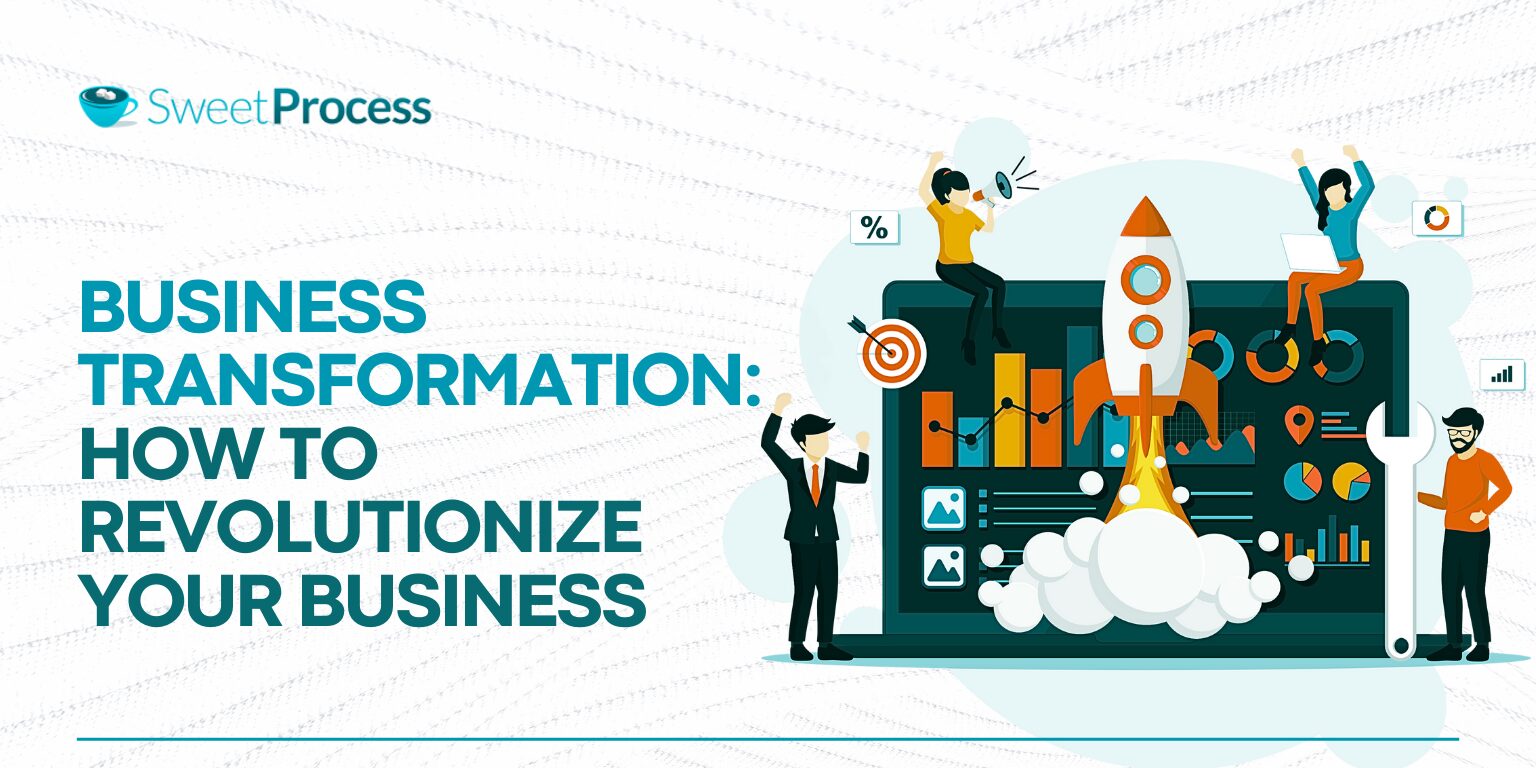
Business transformation is happening in most organizations, but research shows that not every organization is achieving success. A Bain & Company survey revealed that 88% of businesses fail to achieve their transformation goals, often due to poor execution, overwhelmed teams, and lack of a structured approach.
Traditionally, companies focused on stability and profitability before expanding. However, today’s business environment demands more innovation. Companies that embrace transformation, whether through new technology adoption or process automation, have a better chance of attracting more customers and boosting their overall growth.
Your business transformation strategy will essentially rethink how your company operates to achieve long-term efficiency and growth. So what do you need to transform your business and stay ahead of changing trends?
In this guide, we’ll explore the fundamentals of business transformation, walk you through the implementation process, and help you create a clear, actionable strategy to revolutionize your business.
Transforming your business doesn’t have to be overwhelming. With SweetProcess, you can document every step, streamline workflows, and ensure a smooth transition for your team. Sign up for a free trial today and take the first step toward a more efficient, future-ready business!
Table of Contents
What Is Business Transformation?
Types of Business Transformation
How to Transform a Business: A 5-Step Implementation Process
How to Manage Your Company’s Business Transformation Using SweetProcess
Benefits of Business Transformation
The 7 Phases of Business Transformation Process
Business Transformation Best Practices
7 Strategies to Address Common Business Transformation Challenges
Enhance Your Company’s Business Transformation Using SweetProcess
What Is Business Transformation?
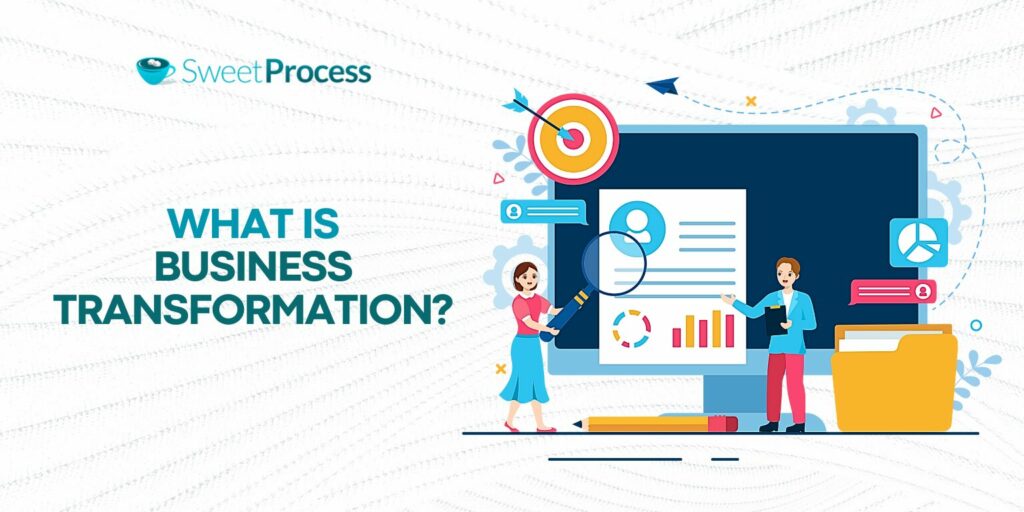
Business transformation involves changing how your organization does business. This could involve altering different aspects of your company to improve performance or increase efficiency.
Organizations hit this goal by:
- Incorporating new technologies
- Changing business strategies
- Restructuring workflows
- Shifting company culture
Think of a business as a car that has been running for years. Over time, parts wear out, fuel efficiency drops, and newer models with better features hit the market. You could continue making minor repairs, but at some point, a complete upgrade or overhaul becomes necessary to stay ahead.
That’s what business transformation does. It ensures your company doesn’t just keep moving but evolves.
To implement this change, you need a clear organizational change management plan that involves all team members and an understanding of the costs and challenges that come with a business transformation.
Types of Business Transformation
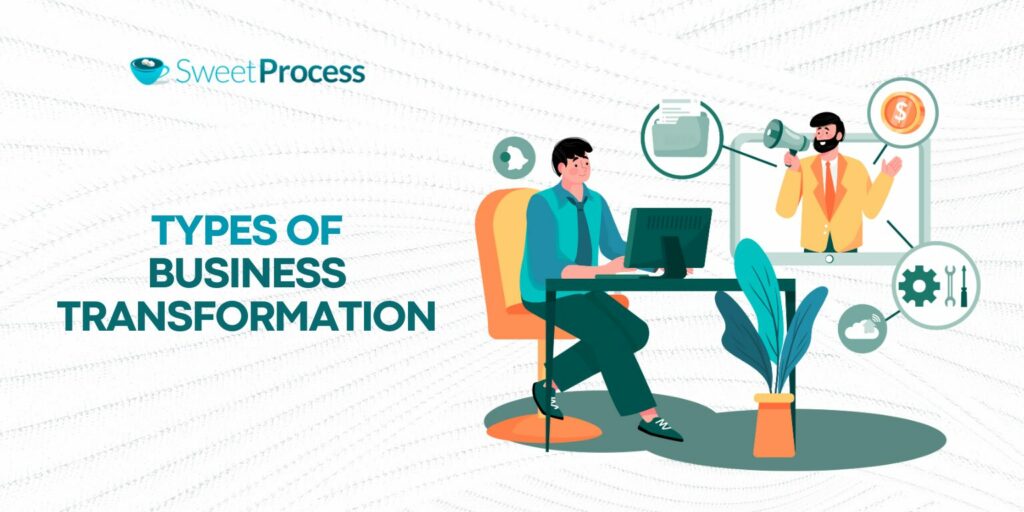
Business transformation can take many forms, depending on your goals, challenges, and industry trends. It should be comprehensive enough to cater to every aspect of your business. Let’s take a closer look at the five main types of business transformation.
Organizational Transformation
Organizational transformation involves reshaping your business structure or operations to prepare for future growth or adapt to market changes. It occurs when you identify a business opportunity that could benefit your operations or when there are industry or legal changes that you need to comply with.
To change your operating model, you can redefine the business goals, restructure departments, or adopt new frameworks that meet these new market demands. It’s common for companies to look into mergers, acquisitions, or a complete overhaul of leadership to achieve this form of transformation.
For instance, if your traditional retail company wants to shift to an omnichannel approach and integrate online and offline shopping experiences, you must complement this strategy to gain a competitive advantage.
A good example is General Electric (GE), which announced plans to split into three companies, focusing individually on the aviation, healthcare, and energy sectors. This strategic move aims to streamline operations and enhance focus in each domain.
Additionally, this transformation will ensure that each independent company is positioned for long-term growth. This decision will allow them to provide value to team members, investors, and customers.
Business Process Transformation
Does your organization continue to use outdated workflows simply because “that’s how it has always been done”? A business process transformation can change this by optimizing the internal process to eliminate inefficiencies.
With a well-documented business process, your team can execute their responsibilities independently. However, if you notice that you are spending too much time on manual, repetitive tasks, it’s time for a process transformation that improves your work.
This process involves:
- Analyzing existing processes to identify inefficiencies
- Introducing better methods such as automation, lean methodologies, and AI-driven optimizations
Your incremental process improvement activities will eventually create a positive impact.
Toyota is well-known for improving its manufacturing processes by applying the Lean Six Sigma principles. The company’s production system stands out globally since it eliminates waste and inefficiency and focuses on continuous improvement. Because of this, Toyota has remained competitive by producing quality products.
The same happened with Domino’s Pizza, which revamped its business processes by embracing digital ordering and delivery tracking systems. These reinvention efforts greatly benefited the company, leading to more sales, significant growth, and improved customer satisfaction.
Management Transformation

Let’s say your company moves from a top-down management approach to a flat organizational structure. You’ll need an action plan to make this adjustment. Management transformation involves changing leadership styles, decision-making frameworks, and company culture to achieve better outcomes.
The key drivers for this change are:
- Leadership changes requiring a new strategic direction
- Declining employee morale or performance
- The need to embrace a more innovative, flexible work environment
The change could be difficult for most employees and departments because the organization would have to shift to a completely different model that aligns with the current goals.
In 2023, Citigroup implemented such a transformation plan when it announced a significant restructuring plan. The bank reduced management layers to streamline its operations and enhance decision-making efficiency. By simplifying its structure, Citibank could consolidate regional operations and boost accountability among the leadership.
Digital Transformation

You can’t avoid digital technologies in your transformation. All business functions, from customer support to sales and marketing, are now powered by new technologies, especially if you want to enhance your market competitiveness.
Digital transformation involves adjusting your business operations to incorporate cloud computing, AI automation, e-commerce, and data analytics technologies. This approach allows you to make data-driven decisions and streamline your workflows.
This transformation is a must-have because of:
- Increased reliance on digital tools and data analytics
- Evolving customer expectations for digital-first experiences
- Competitive pressure from tech-savvy industry disruptors
As one of the biggest retailers, Walmart is always transforming its operations. The retailer has deeply integrated digital transformation into its operations, leveraging AI, IoT, and machine learning to enhance customer experiences and streamline processes. AI plays a critical role across the company, from personalizing customer interactions to optimizing inventory management and supply chain logistics.
The company is also advancing its digital shopping experience by incorporating generative Gen AI into its search function. This will allow them to refine product discovery and browsing for customers, making shopping more intuitive and efficient.
Cultural Transformation
Cultural transformation focuses on shifting workplace values, behaviors, and mindsets to create a more productive, inclusive, and innovative environment and ensure employees align with the company’s mission.
Your organization’s culture influences everything from employee morale and retention to productivity and innovation. However, many businesses struggle with cultural resistance when implementing changes, as employees often fear uncertainty or prefer traditional ways of working.
Therefore, you should have strong leadership skills to manage the team to implement successful cultural transformation. It’s also important to provide clear communication and structured documentation to guide teams through the transition.
Companies like Microsoft have successfully implemented cultural transformation initiatives. Under CEO Satya Nadella, Microsoft underwent a transition centered on collaboration, growth, and innovation. The company started prioritizing real-time product usage insights to refine offerings. Engineers were also given more autonomy by reducing bureaucratic hurdles, allowing them to collaborate freely and focus on innovation.
Because of this, more employees stepped into leadership roles, and the company had many fresh ideas.
How to Transform a Business: A 5-Step Implementation Process
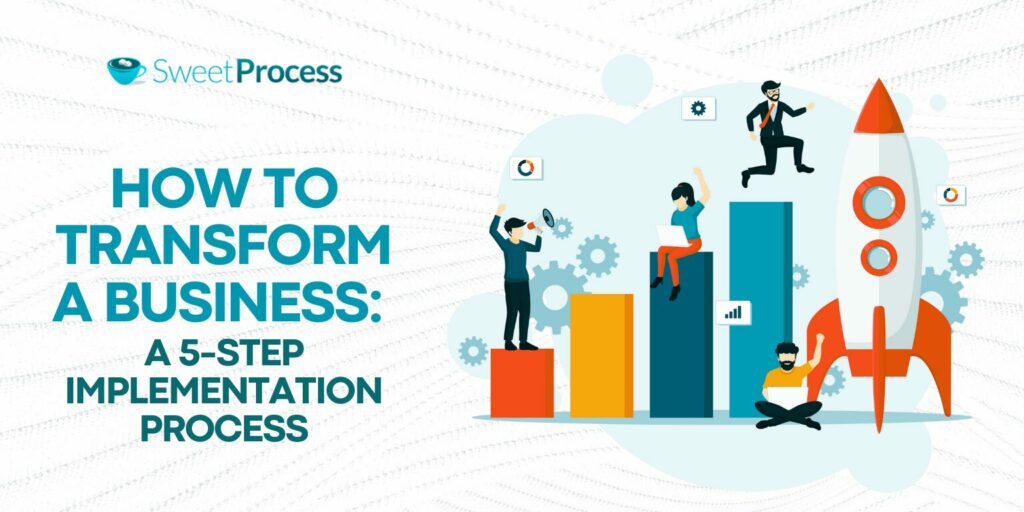
Now that you’ve decided to transform your business, what’s the right approach? In this section, we’ll examine the five essential steps to implement and sustain business transformation successfully.
Clarify Goals
What exactly do you want to achieve with this transformation? Do you want to improve your customer service efforts or optimize your manufacturing process?
Without clear objectives, your business transformation efforts can become scattered, leading to wasted resources and confusion.
For instance, if you want to improve customer experience, a vague goal like “Be more customer friendly” won’t help in the long term. Instead, a clear, actionable goal would be to “Reduce customer service response time from 24 hours to two hours by implementing AI chatbots and a self-service portal.”
With this well-defined goal, your team will be aligned to a shared vision. In addition, you’ll be able to keep your transformation efforts in line with the company’s overall business strategy.
Executive Buy-in
Imagine trying to turn around a large ship without the captain’s approval. The ship remains on its original course no matter how hard the crew rows in a different direction. In the same way, company leadership must actively champion the transformation and not just approve it from a distance.
No matter how innovative or well-planned a transformation strategy is, if leadership isn’t fully committed, it won’t gain the momentum needed for success.
Here’s how to secure executive buy-in:
- Present a strong business case with data-driven insights
- Emphasize the financial, operational, and competitive benefits of transformation
- Involve executives early in the planning process to ensure alignment
Develop Metrics

How do you measure transformation success? The only way to know whether your business investment is yielding results is by setting key metrics to track progress.
For instance, if your organization is undergoing digital transformation, your metrics might include:
- Increased efficiency in internal processes, e.g., task completion time reduced by 40%
- Higher customer satisfaction scores post-implementation
- Revenue growth due to improved digital sales channels
To develop these transformation metrics, identify key performance indicators (KPIs) aligned with your goals. You should also regularly review and adjust strategies based on performance data. This way, you can make changes when necessary. Additionally, you can use this tangible data as proof when communicating results to your stakeholders.
Employee Buy-in
According to a survey by McKinsey, organizations with at least 7% of their employees actively involved in the transformation process are twice as likely to generate higher overall returns for shareholders. This data clearly shows the importance of getting your employees on board; otherwise, your transformation efforts will stall.
Keep in mind that people naturally resist change, especially when it threatens their familiar ways of working. As part of your change management process, you must ensure they understand why you need to change certain operations.
To boost the employee buy-in, here are some key things you can do:
- Explain how transformation benefits them
- Offer learning and development sessions to help employees adapt
- Encourage open communication and feedback to address concerns
Once everyone is on the same page, the implementation will be much smoother.
Demonstrate Success and Build on It
Remember the metrics you developed? They’ll come in handy when you want to show your wins and build momentum. When stakeholders see tangible benefits from change, they become more willing to support and adopt it.
Ensure that you share positive outcomes with everyone. You can also use results to refine your initiatives as well as create a culture of continuous improvement so that the transformation is an ongoing process.
Use the right tools to take charge of your business transformation. SweetProcess helps you map out your strategy to make it successful and sustainable. Sign up for a free 14-day trial today!
How to Manage Your Company’s Business Transformation Using SweetProcess

Managing business transformation without a structured system can become overwhelming. Your teams may struggle with knowledge gaps and inefficiencies since they don’t have proper documentation to guide them.
SweetProcess is a robust tool that helps your business document, manage, and streamline its transformation efforts. Every process is well organized, allowing you to assign tasks and track changes without leaving the platform.
Below, we’ll walk you through how to use SweetProcess features for different transformation tasks.
Document a Business Process
Before making changes, you need to understand your existing workflows and processes. SweetProcess allows you to document step-by-step procedures, ensuring that no crucial tasks are overlooked.
Here’s how to document a business process:
- Log into SweetProcess and navigate to the “Processes” tab.
- Click “Create Process.”

- Enter a clear, descriptive title for the process.

- Break down the process into logical steps, adding images, videos, or instructions where necessary.

- Save and publish the process, making it easily accessible to your team.
Add a Procedure to a Business Process
Business transformation often involves adjusting or refining existing processes. With SweetProcess, you can easily add new procedures to align with your evolving business needs.
Follow these steps to add a procedure to a process on SweetProcess:
- Open an existing business process in SweetProcess.

- Scroll to the “Add Step” section.
- Tap “Procedure.”

- Find an existing procedure or create a new one.

- Keep adding procedures until done.
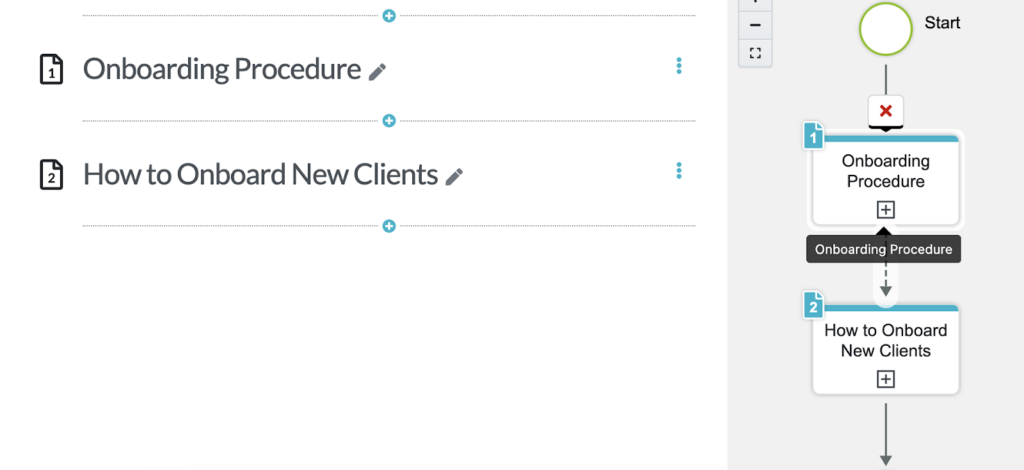
View the Version History of a Business Process
Since business transformation is an ongoing process, you should track changes to ensure clarity and consistency. With SweetProcess’s version history, you can monitor every update, revert to previous versions if needed, and maintain accountability.
Here’s how to view process history:
- Open the business process you want to review.
- Click on the “Version History” icon on the left-hand sidebar to see a timeline of changes.

- Compare different versions, view modifications, and restore previous versions if necessary.
Manage Your Business Process
SweetProcess allows you to edit, refine, and manage processes, ensuring that your transformation efforts remain on track. Follow these steps:
- Open the “Processes” tab.
- Select the process you want to manage. You can edit, share, or export it.
- Click the three dots and pick an action.
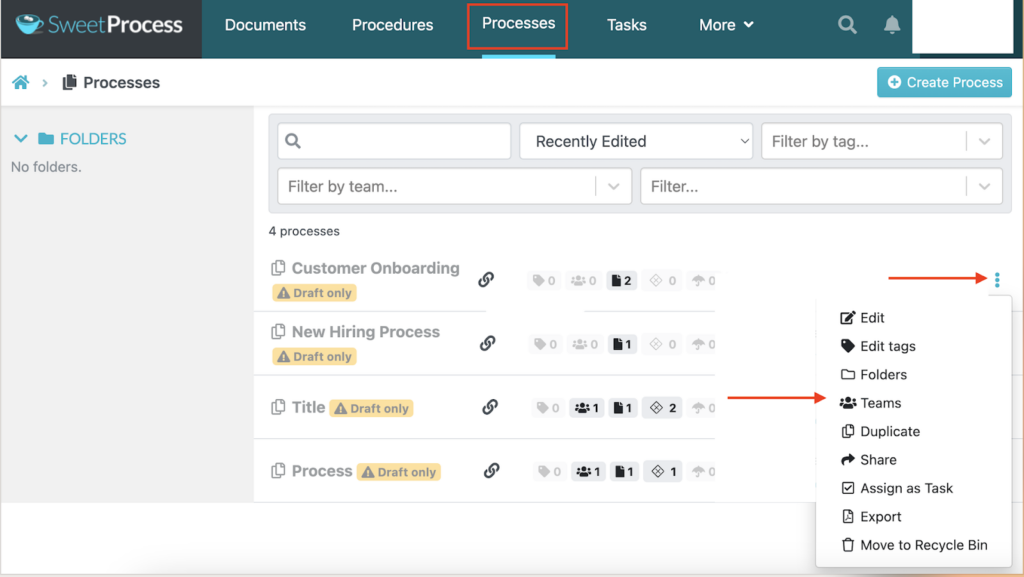
Collaborate Seamlessly With Team Members

Your business transformation isn’t a solo effort—it requires teamwide collaboration. SweetProcess makes it easy for employees to access, contribute to, and follow structured workflows.
Here’s how to collaborate with your team in SweetProcess:
- Select the “Tasks” button and click “Assign Tasks.”

- You can assign these tasks from an existing process or procedure.
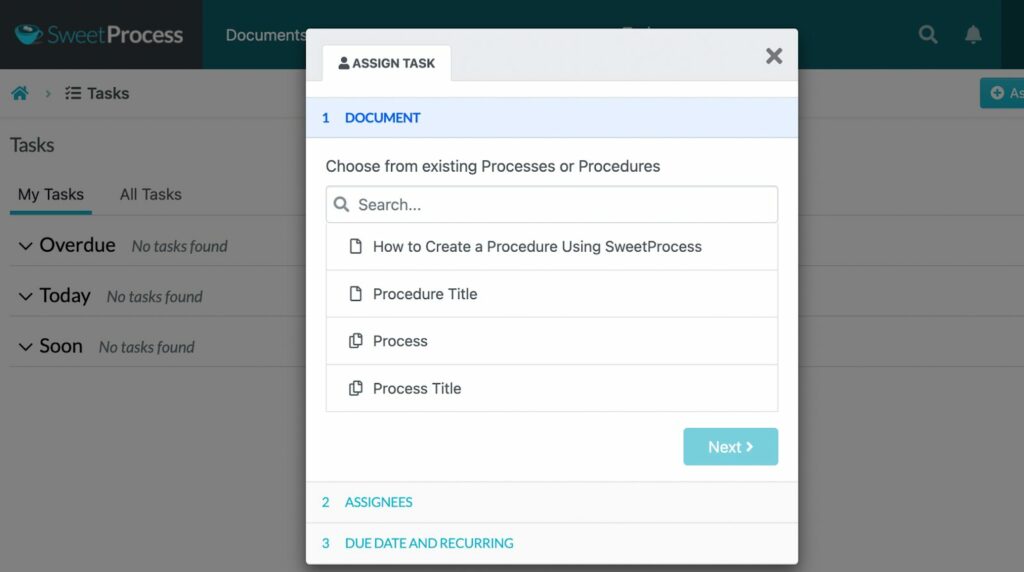
- Pick the specific employee in the “Assignees” section.
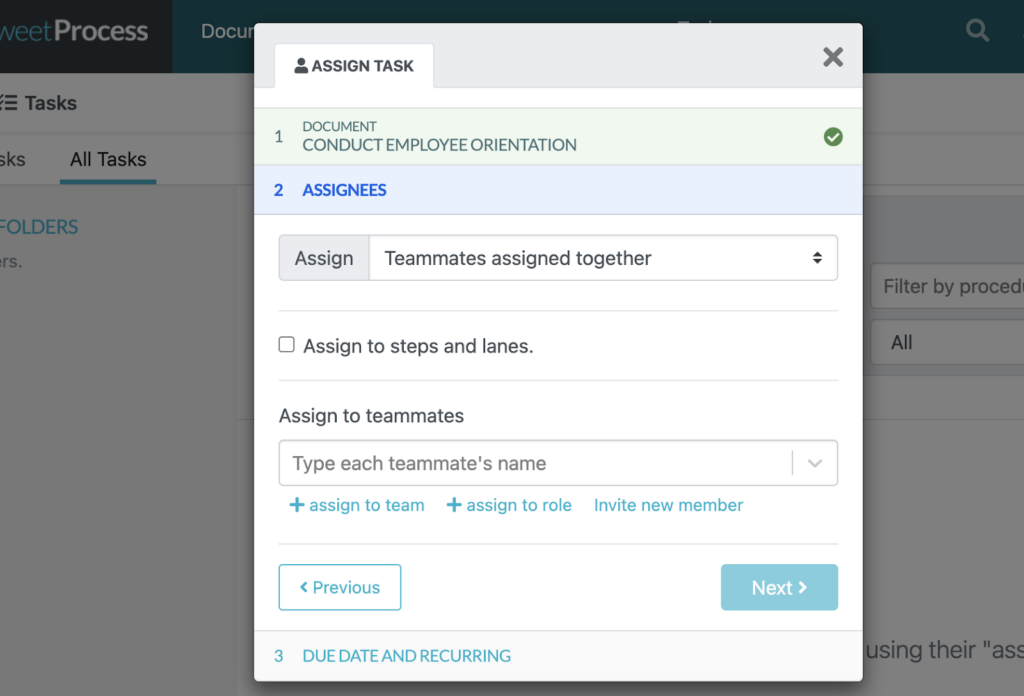
- Add dates for easier tracking.
With SweetProcess, you can also view complete or ongoing tasks. Switch to the “All Tasks” tab to view the list.

One company that has gained a competitive advantage from using SweetProcess is Tameer Inc. This mechanical construction company prides itself on providing high-quality service.
However, President and CEO Bilal Farooq found himself constantly answering employee questions, ranging from holiday schedules to technical work processes. This interrupted his workflow and took valuable time away from high-level business decisions.
While he tried to create employee handbooks and printed guides, they were ineffective in providing employees with the needed information. Frustrated by the inefficiencies, Bilal sought a structured documentation system. After struggling to find the right tool, a consultant introduced him to SweetProcess.
The intuitive nature of the software, combined with its affordability, immediately caught his attention. Since adopting SweetProcess, Tameer Inc. has experienced several improvements:
- Comprehensive knowledge base: Bilal transformed SweetProcess into a company-wide “Google” where employees can instantly find answers to their work-related questions.
- Faster employee onboarding: New hires now undergo mandatory SweetProcess training, significantly reducing onboarding time.
- Time-saving workflow: The CEO saves up to 10 hours daily, as employees and clients can access documented procedures instead of calling him for explanations.
- Scalability for growth: With SweetProcess, all company procedures are documented and accessible, making it easy to train new employees as the business expands.
Another beneficiary of SweetProcess is pLink Leadership. Despite having a clear vision, pLink Leadership struggled with process documentation. Their attempt to manually document procedures resulted in an 85-page Word document that quickly became outdated, difficult to navigate, and overwhelming for employees. Without an accessible, structured system, employees were often unsure how to complete tasks, leading to inefficiencies and frustration.
Determined to find a better solution, Chief Design Officer Jennifer Schneider searched for tools and found a SweetProcess article on standard operating procedures. SweetProcess stood out due to its user-friendly interface, flexibility, and ability to cater to both structured processes and human-centered workflows.
Since implementing SweetProcess, pLink Leadership has transformed its operations and empowered its employees with:
- Effective process documentation and updates: Instead of relying on outdated Word documents, team members now have real-time access to well-structured and regularly updated procedures.
- Seamless employee onboarding and training: New hires can quickly learn processes independently by accessing the SweetProcess knowledge base, reducing training time.
- A centralized, accessible knowledge base: Employees no longer waste time searching for instructions or second-guessing tasks. All procedures are documented and easy to retrieve.
- Integration with existing tools: SweetProcess seamlessly connects with Asana, Slack, and other project management tools, allowing for smooth workflow integration.
Benefits of Business Transformation
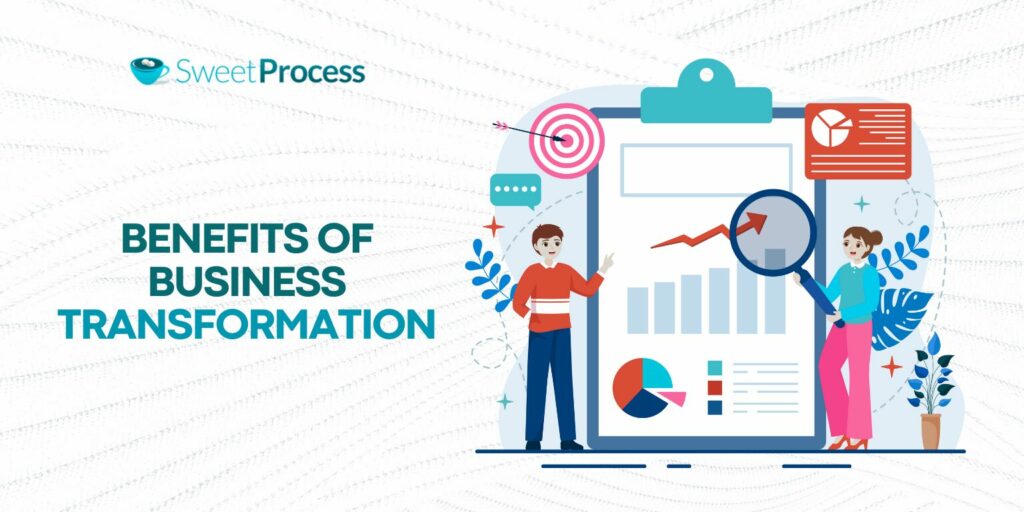
Organizations that successfully transform their processes, culture, or technology strengthen their businesses. Here are the key benefits of implementing this transformation and why it matters.
Enhancing Operational Efficiency and Agility
Imagine a business where employees spend hours searching for files, manually handling repetitive tasks, and constantly fixing errors. This inefficiency costs time, money, and productivity. However, business transformation changes all this by:
- Automating repetitive tasks to reduce errors and save time
- Streamlining decision-making processes, enabling faster execution
- Enhancing flexibility, allowing businesses to adapt quickly to market shifts
By eliminating redundancies, businesses can operate faster and smarter. Prioritizing efficiency not only enhances productivity but also creates a competitive advantage, helping companies scale operations effectively..
Fostering Innovation and Adapting to Market Dynamics

As you run your business, you must remember that markets evolve, customer expectations shift, and new technologies emerge. Failing to adapt to such changes increases the risk of your business becoming obsolete.
A good example is Kodak, who dominated the photography industry for decades but resisted digital transformation. Meanwhile, competitors like Sony and Canon embraced digital technology, ultimately pushing Kodak out of the market.
Transformation boosts innovation by:
- Encouraging a culture of experimentation and creative thinking
- Introducing new business models that align with modern market demands
- Leveraging emerging technologies like AI, automation, and data analytics
An organization that continuously adapts and innovates is better positioned for long-term success.
Improving Customer Experience and Satisfaction
According to data by Zendesk, 76% of customers expect you to provide personalization during your interactions. What’s more, more than one-half will shift to a competitor just because they received one bad experience. It’s evident how fast, seamless, and personalized experiences are more important than ever.
Transforming your operations to prioritize customer needs strengthens brand loyalty and retention rates. You can implement new adjustments to improve response times and service efficiency and use data and analytics to personalize your experiences.
Achieving Sustainable Growth and Long-Term Success
Now that your business is growing fast, can you sustain the growth? Most organizations fail to achieve long-term success due to inefficient processes, outdated systems, and a lack of strategic planning. Business transformation lays the foundation for scalable success by ensuring your operations, leadership, and technology are aligned for future expansion.
Consider how Amazon started as an online bookstore but continuously transformed its business model to become a global e-commerce and cloud computing giant. Its commitment to continuous innovation and adaptability is responsible for the company’s dominance today.
Transformation isn’t just about making changes—it’s about making the right changes with clarity, structure, and efficiency. SweetProcess ensures smooth execution and measurable success. Sign up for a free trial of SweetProcess today!
The 7 Phases of Business Transformation Process
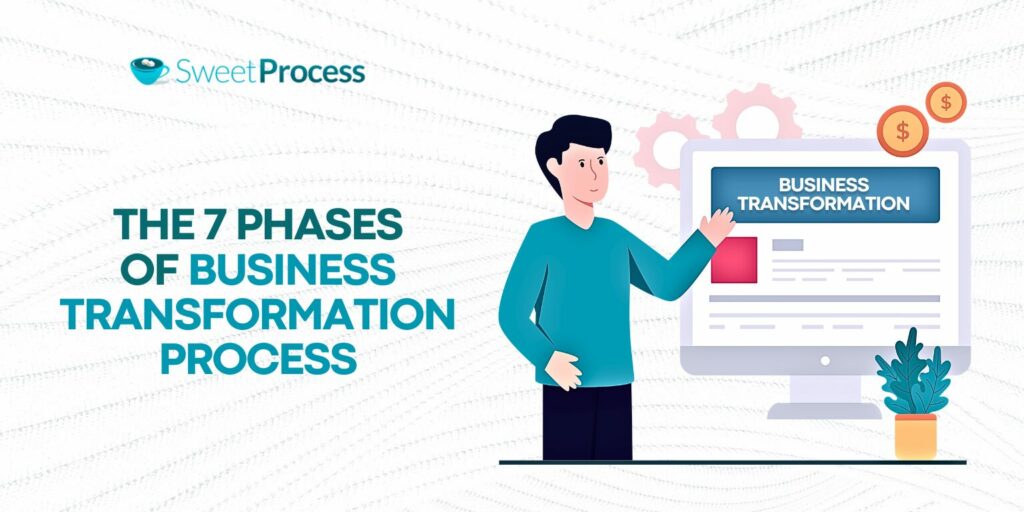
To execute a proper business transformation, you need to structure your journey. You are more likely to succeed in implementing the changes if you follow a clear and phased approach. So what do you need to consider? Here are the critical phases of business transformation to get you started.
Strategy
Before a business begins its transformation, it must first define its purpose. Ask yourself:
- What are the key objectives driving the change?
- Do you want to increase operational efficiency, improve customer experience, or adopt new technology to stay competitive?
This strategy phase involves identifying the “why” behind the transformation and defining measurable objectives to guide the process. Once you have this in place, you can start the transformation process.
Establish Leadership
Have you ever experienced an incident where the leadership was disconnected from major business changes? Without active leadership involvement, employees resist change, and initiatives lose momentum.
Strong leaders set the tone for change, influence company culture, and ensure that changes are driven from the top while gaining employee support at every level. As a business owner or leader, your role is to:
- Define and communicate the vision clearly to employees
- Appoint a dedicated transformation team to oversee the execution
- Encourage a culture of collaboration and accountability
Planning and Scoping

With strategy and leadership in place, the next step is to map out the transformation journey. This phase involves:
- Identifying key processes that will change
- Determining potential challenges and which business areas will be affected
- Identifying required resources
- Setting timelines
As you plan, you can also divide the transformation into manageable phases. This approach allows you to assign tasks to respective employees, ensuring a smooth transition.
Set Up Program Management
You’ll need a structured program if you want to transition from a paper-based to a cloud-based system. This means setting up a program management tool that ensures employees are aligned. Your team members can access this program and keep up with the different phases without missing a step.
Program management frameworks help you track progress and ensure accountability in all departments. Additionally, you can now run an organized and comprehensive transformation process. For the process to be effective, you can:
- Assign program managers to oversee different areas of transformation
- Use project management tools to track progress and timelines
- Establish reporting structures to ensure transparency
Build Resources
Imagine introducing a new system in the organization, but no one knows how to use it. This approach will be detrimental to your business. It might slow down your transformation because you have not equipped your employees.
For the transformation to succeed, it requires the right mix of people, technology, and infrastructure. Therefore, you must hire, train, and equip employees with the necessary tools to implement change effectively.
In addition to training, ensuring that the new processes or systems are fully integrated into company culture is critical. For instance, you could invest in change management software to provide a structured approach for your team. Such tools make the process more seamless, ensuring employees stay on track with the transition.
Execution
This is where the real work begins. The transformation shifts from planning to reality. However, testing or having gradual rollouts is advisable to avoid disruptions. The best approach is implementing changes in phases, measuring impact, and adjusting as needed.
For instance, if a manufacturing company is automating its inventory management system, it may start by implementing it in one facility first. Afterward, the feedback will be used to refine the process before expanding company-wide.
As you execute your plan, keep your employees informed to manage expectations.
Integration
Now that you have a new process or technology, it’s time to integrate it into the existing business functions. This approach ensures that you sustain changes over time. Otherwise, if the new initiatives are implemented separately, your employees may fall back into old habits, undoing all your transformation efforts.
Here are some tips to ensure your transformation is permanent:
- Embed these new processes into the company culture
- Establish continuous improvement mechanisms for your initiatives to keep them successful
Turn your business transformation vision into reality with SweetProcess! You need a tool that makes it easy to document workflows and track progress. Start your free 14-day trial today!
Business Transformation Best Practices
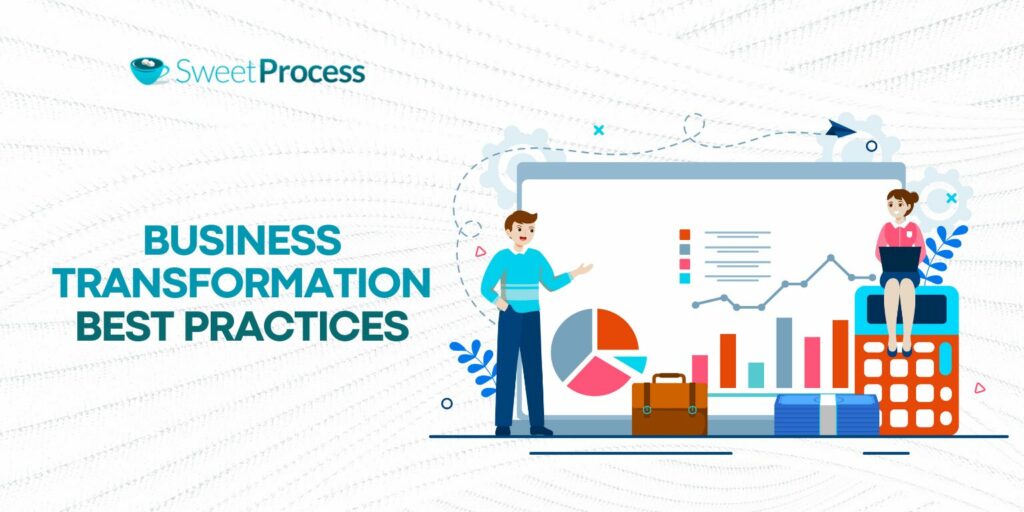
As soon as you begin your business transformation process, you must do everything to keep it on track. Let’s examine some best practices that allow you to navigate transformation effectively.
Assessment
Where does your business currently stand? Before making any changes, you need to clearly understand your organization’s strengths and weaknesses. Start by analyzing your workflows and identifying any inefficiencies that need to be fixed. Rushing into a transformation without a thorough assessment often results in wasted resources. You can conduct employee interviews, collect customer feedback, or check your audits to get this information.
Clear Objectives
Without a defined goal, transformation efforts become directionless experiments. What does success look like for your company? Is it reducing operational costs by 20%, enhancing customer retention, or implementing a full-scale digital upgrade?
Setting clear, measurable objectives ensures that every step taken contributes to the broader vision. This approach is your best bet at avoiding scope creep that could lead to delays, resource drain, and frustration.
A good example of a company that followed this strategy is PepsiCo. The organization embarked on a transformation initiative aiming to become more consumer-centric, faster, and agile. This involved developing clear objectives like increasing productivity and accelerating growth, which helped them streamline operations as one of the top brands.
Strong Leadership

The business leadership needs to be fully engaged in the transformation efforts. On top of approving the initiatives, they should actively advocate for them. This includes setting and communicating expectations with all the stakeholders. In addition, they should demonstrate a commitment to the change so that employees can take cues.
Without executive support, the employees will not prioritize the transformation process.
When Jim Farley took over as Ford’s president and CEO, he announced plans to allocate company resources much better and focus on operational excellence. From the onset, his leadership strategy involved transforming the automotive company into a world-class innovator. Demonstrating strong leadership drives change within the entire organization.
Engage Stakeholders
Your business has multiple stakeholders: employees, customers, investors, and suppliers. When the company makes changes, all of these individuals will be affected. Before making any adjustments, ensure you engage them and get their views so everyone’s needs are considered.
Think about a company transitioning to remote work. If leadership makes the switch without consulting employees, they might overlook critical challenges, such as inadequate home office setups, unclear communication protocols, or gaps in training. Engagement ensures these issues are addressed before they become an issue.
Agile Implementation
Instead of launching a new company-wide system overnight, what about testing it within a single department first? This method gives you time to collect feedback and identify problems that need to be addressed before the full rollout. Pilot programs are effective, especially in large-scale business transformations.
The organization can minimize daily disruptions and implement only processes that have been tested and refined.
A good example is Lego, which was facing financial difficulties in the early 2000s. The company adopted an agile approach by restructuring operations and refocusing product lines, leading to a successful turnaround.
Measure and Adapt
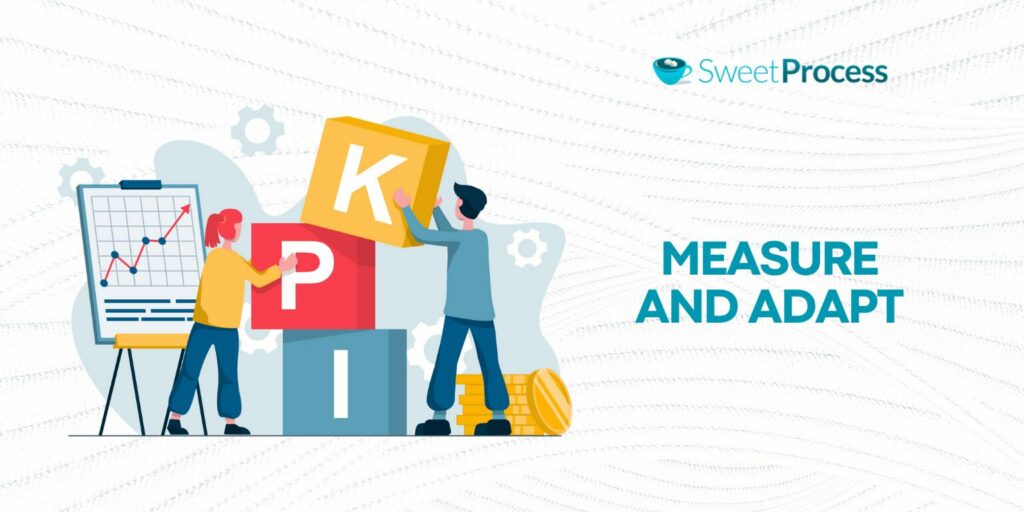
Assuming the transformation is “complete” after implementation increases your chances of losing momentum and slipping back into old and inefficient processes. Business transformation requires constant evaluation and adaptation. Use your KPIs to determine what’s working and eliminate what’s not.
This is an opportunity to improve initiatives to ensure successful transformation.
Starbucks has used this strategy to improve its operations. The company introduced the “Digital Flywheel” program, focusing on personalization and mobile ordering. By collecting data, the company could understand customer needs and habits, enhancing customer engagement and operational efficiency.
7 Strategies to Address Common Business Transformation Challenges

While business transformation is essential for most organizations, it’s rarely smooth. Businesses face internal and external challenges that slow progress or lead to failure. Here are the key challenges businesses face in transformation—and the best approaches to overcome them.
Organizational Inertia or Resistance to Change
Challenge
It’s common for employees and leadership teams to resist change because it disrupts routines, creates uncertainty, and requires extra effort to adapt. Resistance can be in the form of outright pushback or slow adoption of new processes. Most employees would prefer “familiar” systems, which is a huge limitation for transformation efforts.
Approach
Here’s how to deal with this challenge:
- Involve employees early in the process: Employees who feel like active participants rather than passive recipients of change are more likely to embrace transformation.
- Communicate the “why” behind the transformation: Explain how changes will improve workflows, job satisfaction, or company growth.
- Identify change advocates: Your team has some team leaders or respected employees that most people listen to. Enlist them to promote transformation internally.
Uncertainty in Organizational Strategy and Objectives
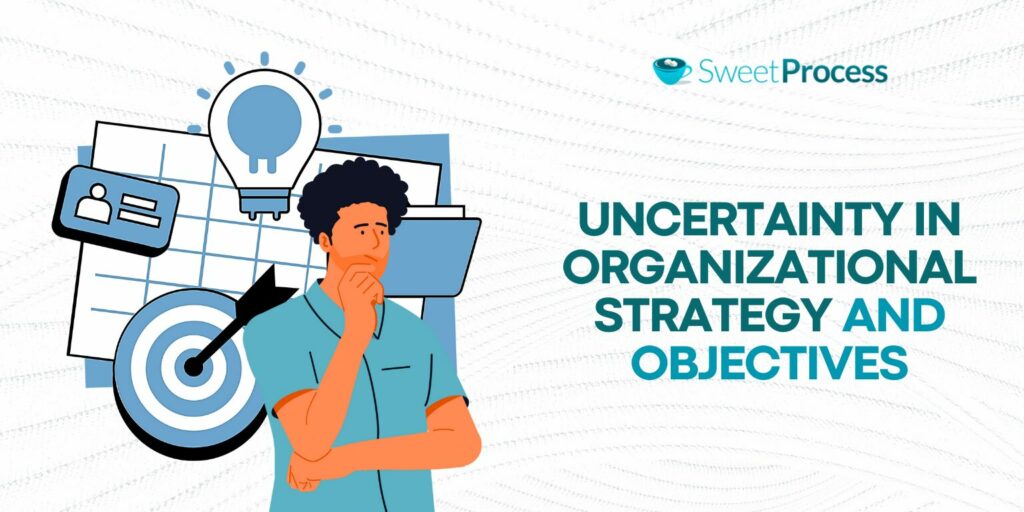
Challenge
Transformation efforts often fail because companies lack a clear, well-defined strategy. If teams don’t know the end goal, you might notice that the transformation becomes inefficient and difficult to sustain.
Approach
You can overcome this challenge by implementing these steps:
- Define specific objectives: Instead of saying, “We want to improve operations,” set a concrete goal like “Reduce manual data entry by 40% within six months.” This way, everyone will know the specific objective you are working toward.
- Align transformation with overall business goals: You can’t have overall company goals that are completely different from transformation efforts. Align them to reduce confusion.
- Regularly reassess and adjust: The business environment evolves over time. Your strategies should be flexible enough to adapt to new challenges and opportunities.
Limited Resources
Challenge
Many companies lack the financial, technological, or human resources to execute transformation fully. Factors like tight budgets, small teams, or outdated infrastructure can slow down progress.
Approach
Here’s how to overcome this challenge:
- Prioritize high-impact initiatives: Focus on changes that provide the most immediate ROI, such as automating manual processes before investing in large-scale system overhauls.
- Leverage external resources: Consider outsourcing, partnerships, or SaaS solutions instead of hiring entire in-house teams for transformation projects.
- Adopt phased implementation: Break down the transformation into manageable stages instead of trying to overhaul everything at once.
Organizational Culture
Challenge
Your organizational culture can either accelerate or block transformation. If teams are used to rigid hierarchies, it becomes harder to introduce changes that will make the structure flexible.
Approach
You can deal with this challenge by:
- Recognizing and rewarding adaptability: Publicly acknowledge employees who embrace transformation, reinforcing the behavior across the entire organization.
- Ensure leadership embodies the change: If leaders resist transformation, employees are unlikely to take it seriously. The transformation should come from the management.
Lack of Robust Change Management Teams and Processes
Challenge
Do you have dedicated teams that could help with transformation efforts? Your business transformation plan could fail if no one takes full ownership of the process. This results in poor execution and a lack of focus on the task.
Approach
You can get your teams on board with the transformation by following these steps:
- Assigning a transformation leader or task force: Ensure there’s someone accountable for keeping projects on track.
- Using structured documentation: With the right tools or software, you can outline new workflows, updated procedures, and responsibilities so that no step gets lost.
- Tracking progress with milestones: Regular check-ins identify bottlenecks early and help teams stay aligned.
Ensuring Smooth and Timely Implementation
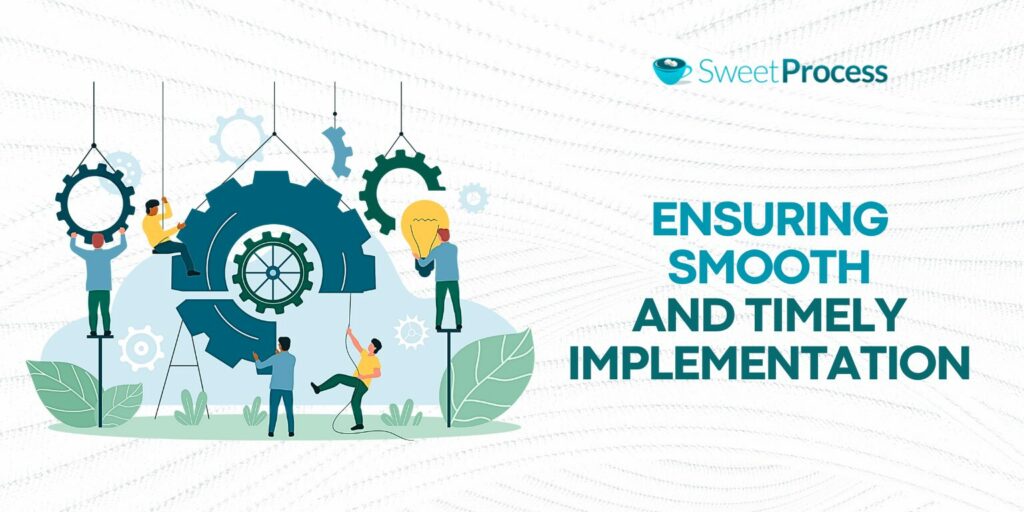
Challenge
Even when plans are solid, you could encounter hiccups that derail your transformation efforts. Delays, miscommunication, and workflow disruptions can cause teams to lose momentum and revert to previous processes.
Approach
Here’s how to overcome this problem:
- Provide hands-on training: Equip employees with practical knowledge so they can seamlessly transition to new processes.
- Develop backup plans: Draft a business continuity plan that contains every contingency in case of disruptions. This approach keeps your business running as you implement transformation initiatives.
Communicating the Value, Progress, and Success of Transformation Initiatives
Challenge
Engagement drops if employees don’t see tangible benefits or understand how transformation helps them. This problem occurs because most business owners and leaders fail to regularly communicate wins, progress, and impact, leading to confusion and skepticism.
Approach
But with these strategies, you can deal with this challenge:
- Highlight early wins: Share this information as soon as you encounter quick successes to build excitement and maintain momentum.
- Provide data-backed updates: Use your KPIs to show how transformation efforts are improving different aspects of your business.
- Create communication channels: Consider organizing meetings or sending newsletters to keep all stakeholders informed.
Ready to simplify and streamline your transformation process? SweetProcess helps businesses document, track, and refine their transformation efforts. Try it today!
Enhance Your Company’s Business Transformation Using SweetProcess

Too often, businesses embark on transformation initiatives without a clear roadmap, leading to frustration, wasted resources, and resistance from teams. However, the organizations that thrive in the current evolving markets document their processes, monitor progress, and create a culture of continuous improvement.
This marks the difference between implementing a successful transformation and a chaotic transition. Without a system in place, your team will struggle to adopt new workflows, knowledge will get lost in emails and meetings, and progress will stall due to confusion.
That’s the power of SweetProcess. By providing a centralized, easy-to-use platform to document, track, and refine every step of transformation, SweetProcess ensures that change is implemented, sustained, and continuously improved.
You don’t have to navigate business transformation alone. Whether you’re streamlining operations, rolling out a new digital strategy, or restructuring your organization, SweetProcess will work for you. Sign up for a free 14-day trial of SweetProcess now!

